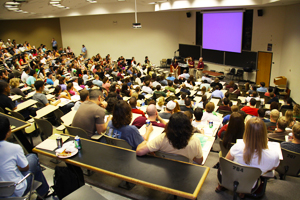The Department of Ecosystem Science and Management (ESSM) had a problem: its curriculum had not been updated in a number of years. As the College of Agriculture and Life Science's leadership emphasized an increased focus on curriculum outcomes, administrators recognized an opportunity to hone the program and to develop innovative new methods to prepare work-ready graduates. The solution involved Texas A&M University’s Center for Teaching Excellence (CTE).
One ecosystem science professor and former CTE client was well-poised to take the lead on this curriculum redesign process. Dr. M. Mort Kothmann ’61 ’68 had attended a CTE sponsored workshop on syllabus development, and was so impressed by what he learned that he registered for the seminar every time he was assigned to teach a new course.
 Dr. Kothmann '61 '68 is a professor in the Department of Ecosystem Science and Management at Texas A&M.
Dr. Kothmann '61 '68 is a professor in the Department of Ecosystem Science and Management at Texas A&M.
“CTE-sponsored events are a great place to get ideas,” Kothmann said. “They are focused on helping faculty do a better job of teaching so that we can do a better job of helping students learn.”
As national and state governing bodies began to put pressure on universities to more accurately assess student learning, the administrators and faculty of ESSM knew the time was ripe to implement change in their department. The process involved thoughtful analysis, candid discussions and programmatic reorganization with a goal to design a better educational experience for the department’s 230 undergraduate students and 100 graduate students.
Initially, the redesign efforts involved a faculty committee to determine exactly what students needed to learn—and how to best teach them—so that they could secure good jobs upon graduation. Kothmann worked closely with CTE Associate Director Dr. Debra Fowler ’03 to facilitate the multi-year project.
 The CTE presents workshops on topics such as course design,assessment, syllabus construction and teaching portfolios.
The CTE presents workshops on topics such as course design,assessment, syllabus construction and teaching portfolios.
The group collected and analyzed data from a variety of sources, including employers, former students and graduating seniors. They also studied the requirements of accreditation bodies and peer universities to discover educational and societal trends. After identifying the qualities of an ideal graduate, the faculty agreed upon relevant content and learning outcomes—knowledge, skills and attitudes—for effective graduates.
The faculty then analyzed the ESSM curriculum to identify gaps and to determine the best sequence of courses to build on concepts that were taught in lower-level classes. During the multi-year process, the college had combined two departments (range land ecology management and forest sciences) into one (ecosystem science and management), which added an additional challenge.
The final steps of the curriculum involved developing an assessment plan, and identifying professional development and additional resources that faculty would need to accomplish the redesign.
“This process helped faculty members understand that you can’t cover a topic just once in class,” said Dr. Georgianne Moore, ESSM associate professor. “It needs to show up in an early class so students get that exposure right away and know what it is. We can then reinforce the topic in a later class and ask students to apply what they have learned.”
The CTE actively supported the ESSM faculty as they worked through each step of the process. “CTE was crucial in the success of this effort by helping plan and facilitate the workshops,” Kothmann said. “They also recorded the proceedings and produced documents that we could take back to work with faculty.”
Curriculum redesign is just one of many professional development tools offered through the CTE, which is part of the Office of the Dean of Faculties and Associate Provost at Texas A&M. The center also hosts workshops and other enrichment opportunities for faculty members on topics such as course design, engaging students with technologies, and working with students who have disabilities. In addition, the center offers special programs that support new faculty and graduate students.
Kothmann says the process led to a major shift in faculty thinking in his department. “It changes the way you think, the way you act, the way you build and assess your courses,” he said. “I know it has significantly changed my teaching for the better.
- By Dorian Martin
This article was originally published in the summer 2014 issue of Spirit magazine.
Texas A&M Foundation
The Texas A&M Foundation is a nonprofit organization that solicits and manages investments in academics and leadership programs to enhance Texas A&M’s capability to be among the best universities.
You can support the Center for Teaching Excellence with a gift of an endowment to the Texas A&M Foundation. For additional information, contact Carl Jaedicke '73 with the Foundation at (800) 392-3310, (979) 845-6551 or cjaedicke@txamfoundation.com.